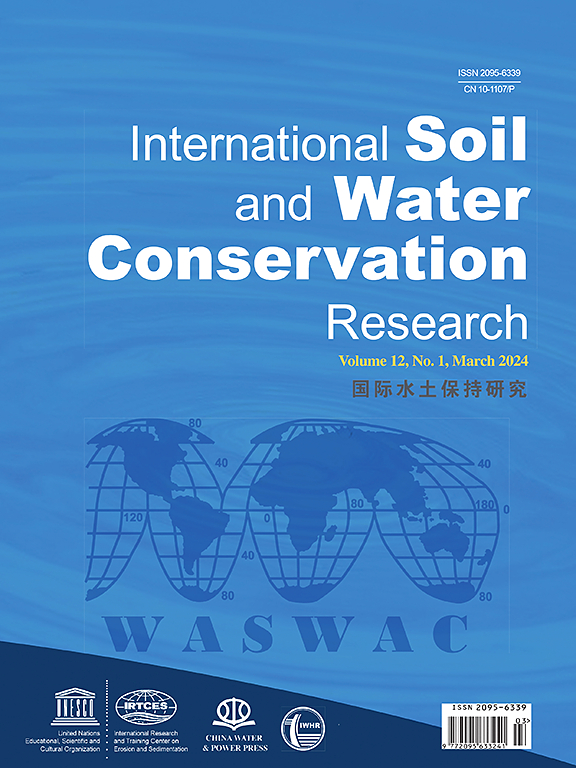Dealing with sub-pixel landscape elements in distributed rainfall-runoff modelling in agricultural catchments
IF 7.3
1区 农林科学
Q1 ENVIRONMENTAL SCIENCES
International Soil and Water Conservation Research
Pub Date : 2025-03-01
DOI:10.1016/j.iswcr.2025.02.009
引用次数: 0
Abstract
Vegetated landscape elements (vLEs) (e.g. hedges and grass buffers) are increasingly recognised for their ability to retain more water longer and mitigate downstream flood risk. To optimise positioning of these –typically small– vLEs, the impact of possible configurations needs quantifying, often requiring numerous hydrological model runs. To limit computational time, models must be run at lower spatial resolution leading to sub-pixel vLEs. The performance of a distributed rainfall-runoff model at 5 m resolution was assessed for 15 historical rainfall events in a 191 ha agricultural watershed in the Belgian loess belt. The model was then upscaled to 20 m resolution using four scaling approaches for saturated hydraulic conductivity (Ks) and Manning's coefficient, and three methods to set the hydro-physical parameters of subpixel vLEs in the upscaled model. The high-resolution model performed best for Ks equaling 0.72 mm h−1. The upscaled model performed best when applying a flow length-based scaling factor for the Manning's coefficient, decreasing the RMSE by 25% and 10% for discharge volume and peak discharge rate respectively. Adjusting Ks and Manning's coefficient of vLE pixels using upslope area-based weighting was most effective for discharge volume, achieving an RMSE of 10.80% and R2 of 0.64. Peak discharge rate could not be modelled accurately with sub-pixel vLEs at 20 m resolution. Our research can support scenario analysis in which accounting for the reduction of discharge volume caused by the presence of vLEs and their spatial configurations matters and therefore can support landscape design studies in the context of flood risk mitigation.
农业流域分布式降雨径流模拟中亚像元景观要素的处理
植被景观元素(例如树篱和草地缓冲)因其长时间保留更多水分和减轻下游洪水风险的能力而日益得到认可。为了优化这些典型的小vle的定位,可能配置的影响需要量化,通常需要大量的水文模型运行。为了限制计算时间,模型必须在较低的空间分辨率下运行,从而导致亚像素vle。对比利时黄土带191公顷农业流域15次历史降雨事件的5 m分辨率分布式降雨径流模型的性能进行了评估。然后使用4种饱和水力导率(Ks)和Manning系数的缩放方法,以及3种设置亚像素vLEs的水物理参数的方法,将模型升级到20 m分辨率。高分辨率模型在k = 0.72 mm h−1时表现最佳。当对曼宁系数采用基于流量长度的比例因子时,升级模型表现最佳,流量和峰值流量的RMSE分别降低了25%和10%。使用基于上坡面积的加权方法调整vLE像素的Ks和Manning系数对排水量最有效,RMSE为10.80%,R2为0.64。在20 m分辨率下,亚像素vLEs不能准确模拟峰值放电率。我们的研究可以支持情景分析,在情景分析中,考虑到vle的存在及其空间配置导致的排放量减少,因此可以支持减轻洪水风险背景下的景观设计研究。
本文章由计算机程序翻译,如有差异,请以英文原文为准。
求助全文
约1分钟内获得全文
求助全文
来源期刊

International Soil and Water Conservation Research
Agricultural and Biological Sciences-Agronomy and Crop Science
CiteScore
12.00
自引率
3.10%
发文量
171
审稿时长
49 days
期刊介绍:
The International Soil and Water Conservation Research (ISWCR), the official journal of World Association of Soil and Water Conservation (WASWAC) http://www.waswac.org, is a multidisciplinary journal of soil and water conservation research, practice, policy, and perspectives. It aims to disseminate new knowledge and promote the practice of soil and water conservation.
The scope of International Soil and Water Conservation Research includes research, strategies, and technologies for prediction, prevention, and protection of soil and water resources. It deals with identification, characterization, and modeling; dynamic monitoring and evaluation; assessment and management of conservation practice and creation and implementation of quality standards.
Examples of appropriate topical areas include (but are not limited to):
• Conservation models, tools, and technologies
• Conservation agricultural
• Soil health resources, indicators, assessment, and management
• Land degradation
• Sustainable development
• Soil erosion and its control
• Soil erosion processes
• Water resources assessment and management
• Watershed management
• Soil erosion models
• Literature review on topics related soil and water conservation research
 求助内容:
求助内容: 应助结果提醒方式:
应助结果提醒方式:


